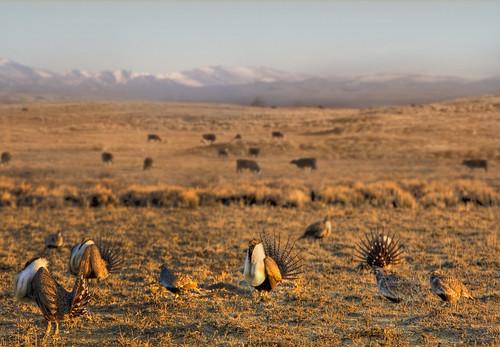
The population of the greater sage-grouse has grown by nearly two-thirds since 2013, according to a new survey. USDA NRCS photo.
The U. S. Fish and Wildlife Service (FWS) designated greater sage-grouse in 2010 as a candidate for listing under the Endangered Species Act (ESA). Later this year, the FWS will determine whether to list the species or remove it from consideration based on the conservation actions implemented to remove threats across the range. However, a recent survey points towards an optimistic outlook for sage grouse.
USDA’s Natural Resources Conservation Service (NRCS) has been working for the past five years through the Sage Grouse Initiative (SGI) to proactively conserve sage grouse and sustain the working rangelands that support western ranching economies. During this time, this innovative partnership led by NRCS has joined forces with 1,100 ranchers who have conserved 6,000 square miles of habitat, an area of working lands twice the size of Yellowstone National Park. Partnership investment of more than $424 million has been highly targeted to areas of high bird abundance to maximize benefits to populations.
A recently released SGI report provides a summary of the impressive accomplishments achieved through the initiative, including more than 400,000 acres that were restored through removal of encroaching conifers, and nearly 500,000 acres that were conserved through the establishment of conservation easements. In addition to the numbers, this report also highlights the people and partnerships behind the numbers — the ones that put the conservation on the ground.
“Through collaboration, our goal is to help ensure a bright future for sage grouse and the 350 other wildlife species that call this range their home, while ensuring the nation’s working lands remain productive,” said Tim Griffiths, who helps coordinate NRCS’ sage grouse efforts through the agency’s Working Lands for Wildlife partnership. “We’ve made great progress since 2010 and will maintain our focus on this critically important ecosystem.”
According to Western Association of Fish and Wildlife Agencies (WAFWA) survey results, the population of the greater sage-grouse has grown by nearly two-thirds since 2013.
“Our lek count data shows an increase in male sage grouse from 49,397 in 2013 to 57,399 in 2014 and 80,284 males in 2015,” said San Stiver, WAFWA’s sage grouse coordinator.
The report also said that Western state biologists observed more active breeding grounds, known as leks, over the past two years, as well as a major increase in the number of male grouse per lek. In 2006, biologists observed an average of more than 33 birds per lek, higher than at any time in decades. But that number fell each year until 2013, when there were fewer than 17 birds per lek. It rose to 18 in 2014 and 25 this spring.
Stiver said. “I wouldn’t suggest this is a trend at this point, as it is not enough years for a trend, but it is clearly good news.”
Earlier this year, the FWS determined a subpopulation of sage grouse in Nevada and California, called the Bi-State sage-grouse, did not require listing under the ESA. This decision shows the success of NRCS supported voluntary conservation efforts on private lands that benefit wildlife while supporting working lands.
Learn more about NRCS’ wildlife conservation efforts. To get started with NRCS, visit your local USDA Service Center or www.nrcs.usda.gov/GetStarted.
No comments:
Post a Comment
Note: Only a member of this blog may post a comment.